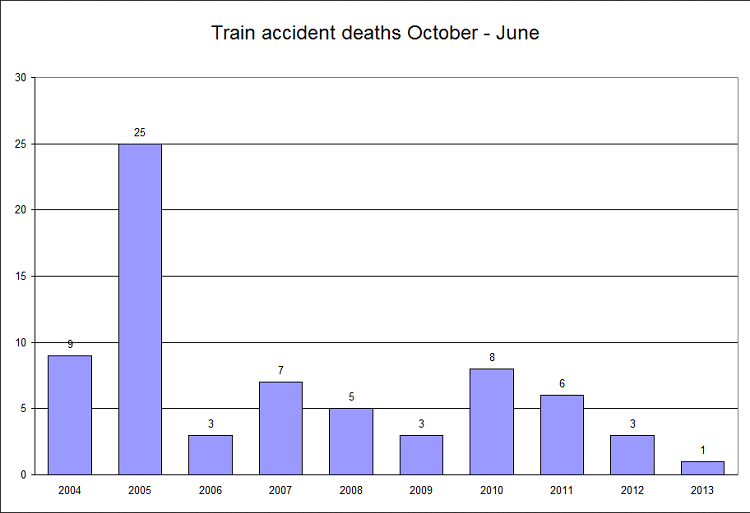Coyote Blog indulges in a good old-time fisking of an article built on the claim that there has been a “trend” of increasingly deadly railway accidents:
The best way to explain the phenomenon is with an example, and the Arizona Republic presented me with a great one today, in the form of an article by Joan Lowy of the Associated Press. This in an article that reads more like an editorial than a news story. It is about the Federal requirement for railroads to put safety electronics called Positive Train Control (PTC) on trains by a certain date. The author has a pretty clear narrative that this is an absolutely critical piece of equipment for the public good, and that railroads are using scheming and lobbying to unfairly delay and dilute this critical mandate (seriously, I am not exaggerating the tone, you can read it for yourself.)
My point, however, is not to challenge the basic premise of the article, but to address this statement in her opening paragraph (emphasis added).
Despite a rash of deadly train crashes, the railroad industry’s allies in Congress are trying to push back the deadline for installing technology to prevent the most catastrophic types of collisions until at least 2020, half a century after accident investigators first called for such safety measures.
The reporter is claiming a “rash of deadly train crashes” — in other words, she is saying, or at least implying, that there is an upward trend in deadly train crashes. So let’s ask ourselves if this claimed trend actually exists. She says it so baldly, right there in the first seven words, that surely it must be true, right?
[…]
So let’s go to the data. It is actually very easy to find, and I would be surprised if Ms. Lowy did not actually have this data in her hands. It is at the Federal Railway Administration Office of Safety Analysis. 2013 data is only current through June and seems to be set up on an October -September fiscal year. So I ran the data only for October-June of every year to make sure the results were comparable to 2013. Each year in the data below is actually 9 months of data.
By the way, when one is looking at railroad fatalities, one needs to understand that railroads do kill a lot of people every year, but the vast, vast majority of these — 99% or more — are killed at grade crossings. People still do not understand that a freight train takes miles to stop. (see postscript below, but as an aside, I would be willing to make a bet: Since deaths at grade crossings outnumber deaths from collisions by about 100:1, I would be willing to bet any amount of money that I could take the capital the author wants railroads to invest in PTC and save far more lives by investing it in grade crossing protection. People like Ms. Lowy who advocate for these regulations never, ever seem to consider prioritization and tradeoffs.)
Anyway, looking at the data, here is the data for people killed each year in US railroad accidents (as usual click to enlarge any of the charts):
So, rather than a “rash”, we have just the opposite — the lowest number of deaths in a decade. One. I will admit that technically she said rash of “fatal accidents” and this is data on fatalities, but I’m going to make a reasonable assumption that one death means one fatal accident — which certainly cannot be higher than the number of fatal accidents in previous years and is likely lower.
Most of you will agree that this makes the author’s opening statement a joke. Believe it or not — and this happens a surprising number of times — this journalist is claiming a trend that not only does not exist, but is of the opposite sign.




